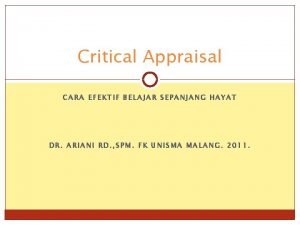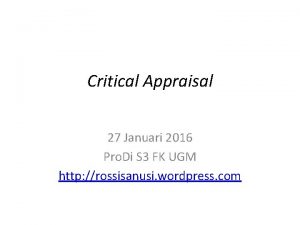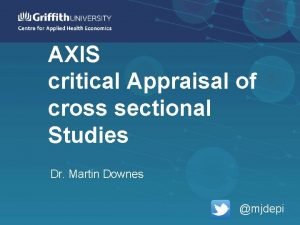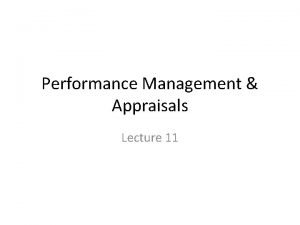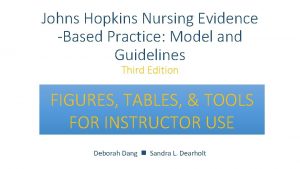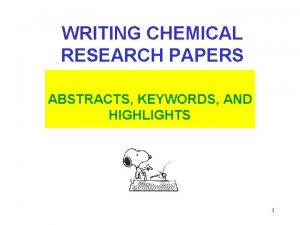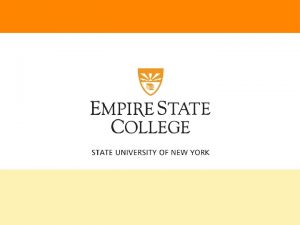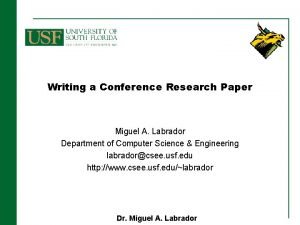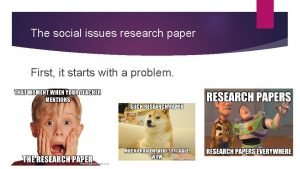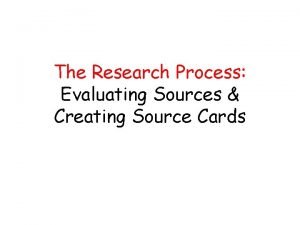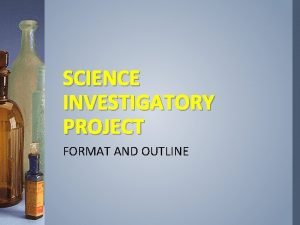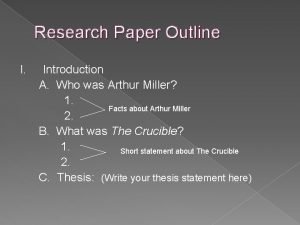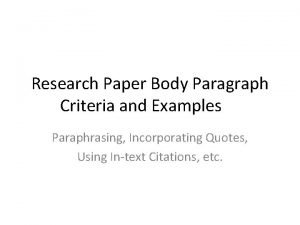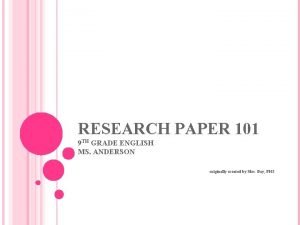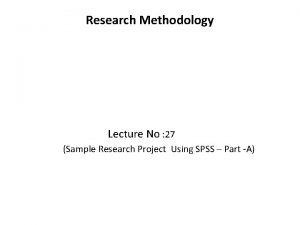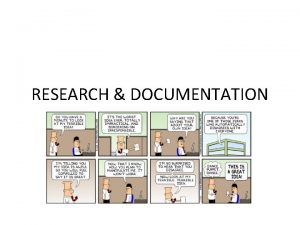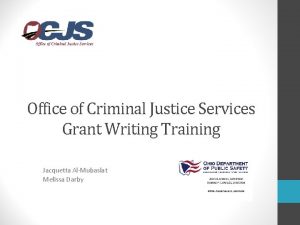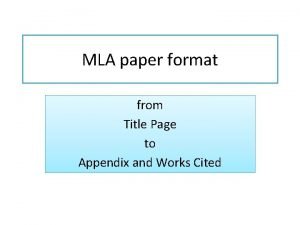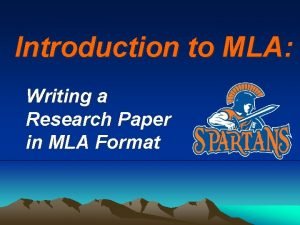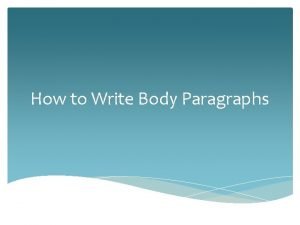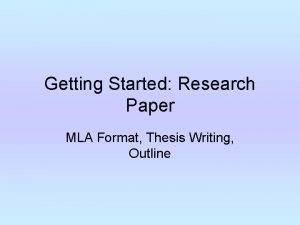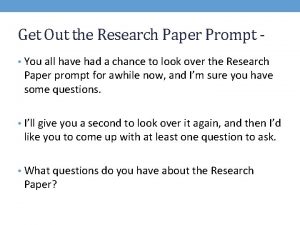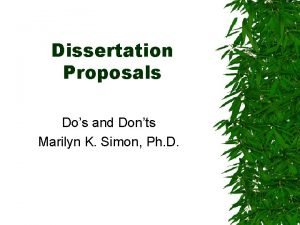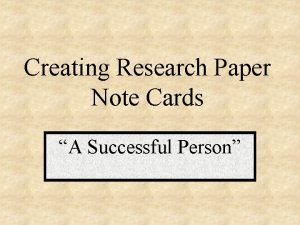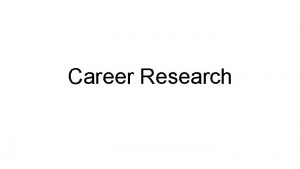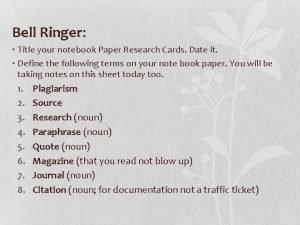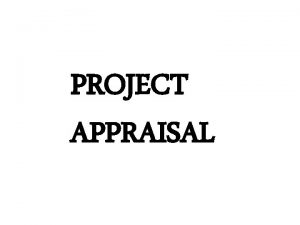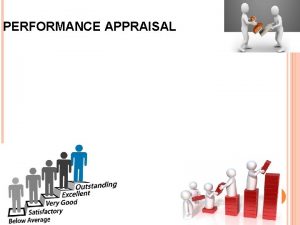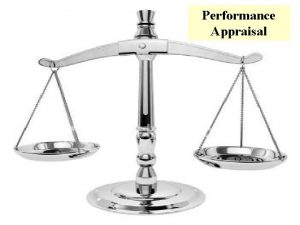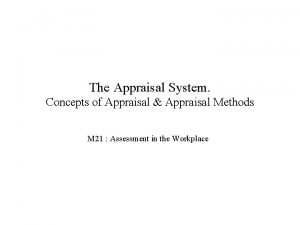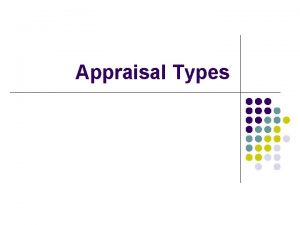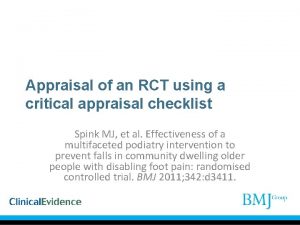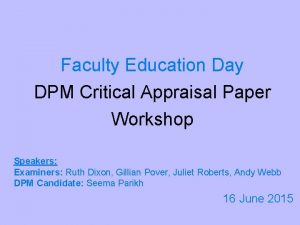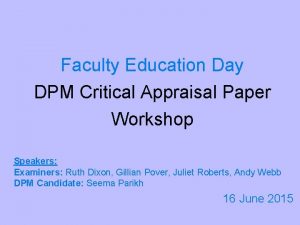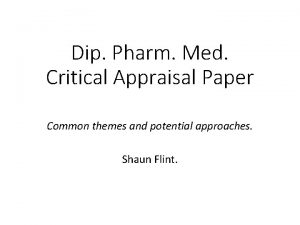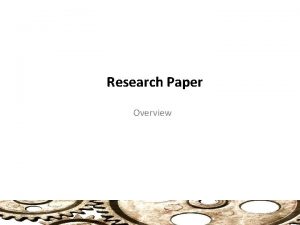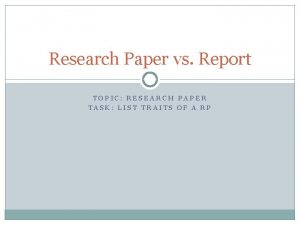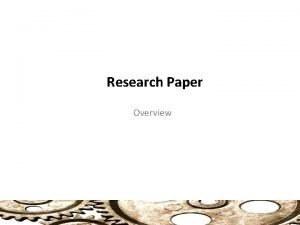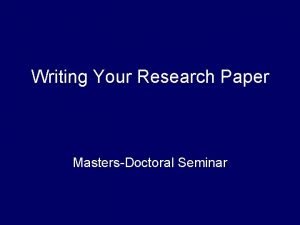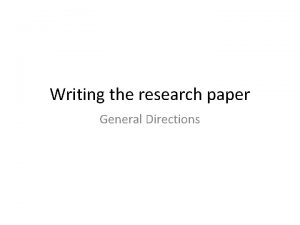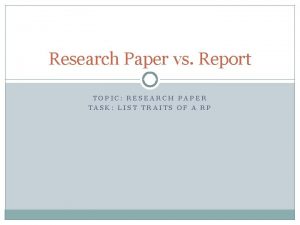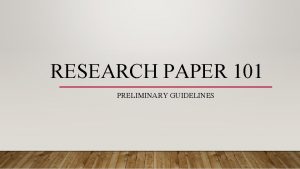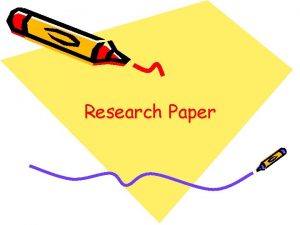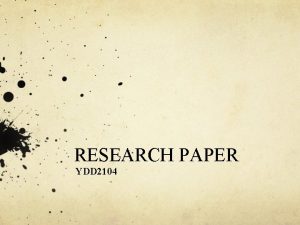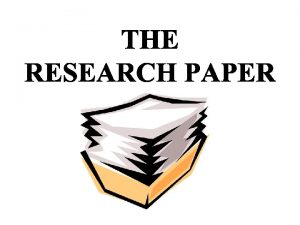Critical Appraisal Critical Appraisal Analyze the research paper

































































![• Salzmann et al. [26] had also shown that Lysholm, Tegner and Visual • Salzmann et al. [26] had also shown that Lysholm, Tegner and Visual](https://slidetodoc.com/presentation_image_h2/9564fa51613ea98920750c3202f7e1a8/image-66.jpg)

















- Slides: 83

Critical Appraisal

Critical Appraisal Analyze the research paper to judge its trustworthiness, its value and relevance Identify the strengths and limitations in a research paper 2

Anatomy of a Scientific Article • • • Abstract Introduction Materials and Methods Results Discussion Conclusion/ Recommendation 3

Steps of evidence based Medicine 1. 2. 3. 4. 5. patient presents with a clinical problem Formulate a focused research question Search for the best evidence Critically appraise the evidence you find Decide the action to take from findings &evaluate your new practice


• Critical appraisal 1 -Evaluate of the study design 2 -Assess the methodology 3 -suitability of the statistical methods 4 -Relevance of the research to one's own practice


Relevance Personal Knowledge Validity Methods Section Results Section Applicability Personal Interpretation/ Experience

Relevance • 3 C 1. Would I care about the outcome 2. Is the topic common to my practice 3. Would the new knowledge change my practice

TYPES OF STUDIES 1. Studies on the natural history of disease 2. Studies on etiology or causes of disease (cohort studies, case control studies) 3. Studies on benefits of therapy (Clinical trials) 4. Studies on the value of diagnostic tests 5. Studies on prognosis 6. Studies on systematic reviews and meta-analyses 7. Studies on cost and economic analyses 8. Studies on clinical practice guidelines 9. Studies on quality of life measurements

Category Therapy Description Preferred Study Design Tests the effectiveness of a Randomized, double-blinded, placebotreatment, such as a drug, surgical procedure, or other intervention controlled trial Diagnosis and screening Measures the validity and reliability effectiveness of a diagnostic test, Cross-sectional survey Causation Assesses whether a substance is related to the development of an illness or condition Cohort or case-control Prognosis Determines the outcome of a disease Longitudinal cohort study (comparing the new test with a reference standard)

Validity • Were sound scientific methods used? • Bias: A systematic error, either selection, or information. • Confounding: An unmeasured interacting factor • Power: was it addressed Evaluation skills are needed A knowledge of the subject, statistical tests, and research design

Knee Surg Sports Traumatol Arthrosc (2013) 21: 146– 151 Knee surgery, sports. Traumatology Arthroscopy official journal of the ESSKA European Society of Sports Traumatology Knee Surgery and Arthroscopy



Journal impact factor (JIF) • is a measure reflecting the yearly average number of citations to recent articles published in that journal. • It is frequently used as a proxy for the relative importance o a journal within its field;


AUTHORS





Examining the paper

1

Author details • Who wrote the paper? • Institutions • Name of journal • Impact factor of the journal

2

Abstract • Structured abstract • Does it address a related question? • Is the study properly designed analyzed? • Are the results important and worth knowing about? • Do you want to know more after reading the abstract? • Are there reasons to doubt the findings without reading the whole article?


3

Introduction • Is the research question clearly described? • Is the study important to answer this question? • Is the relevant background described? – What is already known and not known on the topic? – How this study differs from the previous similar studies? • Is the literature search adequate?


• Valgus HTO is a common procedure for the treatment of early medial OA • Severe medial arthrosis, ligamentous knee instability, PFA , deficits in ROM, tibial thrust and undercorrection, or overcorrection negatively influence the results of HTO. • All these risk factors and their relation to the different surgical methods are well known. However, the data regarding the influence of age at the time of surgery on the outcome are scanty.

• To our knowledge, there are only three studies, which concentrate on the investigation of age as a factor influencing the outcome of valgus HTO. • Two of these studies focused on patients under 50 years of age without comparison to older patients. • Only Trieb et al. compared the outcome and survival rates of older patients to younger ones. However, they divided the groups into patients older and younger than 65 years and only described the survival of the osteotomy and not the functional outcome.


• The aim of our study was to evaluate the factor of age in predicting the functional outcome after valgus HTO, and • we hypothesized that valgus HTO leads to equal results in the treatment of varus osteoarthritis independent of the age of the patient. • For this, a matched-pair study on patients above 55 years and those 14 to 16 years younger was performed to compare directly the operative results of older to younger patients.

Introduction • Is the research question clearly described? • Is the study important to answer this question? • Is the relevant background described? – What is already known and not known on the topic? – How this study differs from the previous similar studies? • Is the literature search adequate?

4

Methods Study design appropriate for question? • What is the Study design • How were the participants selected? • Justification of sample size?

• Prospective or retrospective data collection? • Are the outcomes of interest defined and measured adequately? • Statistical methods appropriate? • Ethical approval?

Materials and methods • We performed a matched-pair analysis by comparing • patients older than 55 years with a median age of 57 years (55– 63) (group A) • with patients 15 ± 1 years younger with a median age of 42 years (39– 47) (group B) • who both received a HTO between 1/2001 and 10/2007.

matching criteria: • Age (over 55 ys compared to patients 15 ys younger) • • Gender (M-F ) Operative method (open wedge–closed wedge), Osteosynthesis method (different locking plates), Additional operations microfracturing, partial internal meniscus resection less 1/3, OATS medial femoral condyle, anterior cruciate ligament reconstruction), • body mass index and follow-up time. the maximum difference between the patients of group A and B regarding to the body mass index was 2 points and regarding to the follow-up time 6 month • Furthermore, the patients of each pair showed a comparable activity level according to their work load.

• • • Exclusion criteria for all patients Chronic or acute ligament instability without reconstruction, lateral OA , absence of the lateral meniscus, Chronic inflammatory diseases like RA metabolic diseases (e. g. diabetes mellitus), hereditary diseases affecting the musculoskeletal system, drug abuse and alcohol abuse

• Finally, there were 13 matched-pairs with 18 male and 8 female patients fulfilling the inclusion criteria. • The median age of group A at the time of surgery was 57 years while the median age of group B was 42 years • The median overall follow-up was 64 months (23– 90) with 68 months in group A and 63 months in group B. • the median BMI was 26. 5 with 26. 0 in group A and 26. 6 in group B. • The degree of osteoarthritis was evaluated with the help of radiographs in three plains (AP, lateral, patella tangential) based on the classification of osteoarthritis by Kellgren and Lawrence. The imaging was not predated than 3 months at time of surgical procedure. • . The median grade of osteoarthritis for the medial compartment was 2 points in group A and also 2 points in group B. Moreover, the median grade of osteoarthritis for the lateral compartment was 0 in group A and 0 in group B.

A B 57 42 68 M 63 M BMI 26 26. 6 degree of osteoarthritis M 2 2 degree of osteoarthritis L 0 0 AGE FOLLOW UP correction Median 8 (5– 14) degrees



• Median correction was 8 (5– 14) d in both groups. • Closed wedge osteotomy was performed in 18 open wedge osteotomy in the remaining 8 subjects. • There were additional procedures in 16 cases, which consisted of microfracturing (6), partial internal meniscus resection less 1/3 (12), OATS therapy of the medial femoral condyle (4) and anterior cruciate ligament reconstruction (4). • The study was performed in accordance with the Declaration of Helsinki. Informed consent from each participant was obtained prior to investigation.

Operative technique • Arthroscopy • closed wedge osteotomy using a non-locking plate (Lplate, ) and open wedge osteotomy using two different locking plates (Puddu Plate 2 nd, Arthrex, and Tomo. Fix Medial Tibial Head Plate, ). • The new mechanical axis was fixed at the Fujisawa position • In accordance with the matched-pair criteria, we only compared patients who underwent similar osteotomies with similar osteosynthesis methods and similar additional surgical procedures.

Tomo. Fix Medial Tibial Head Plate, Germany

Puddu Plate 2 nd, Arthrex

Outcome analysis • The evaluation of the outcome was conducted using a special questionnaire regarding pain (strong pain, moderate pain, sometimes pain and no pain), overall satisfaction (very satisfied = 1, satisfied = 2, partially satisfied = 3, not satisfied = 4), repetition of surgery (‘I would undergo the surgery again’, ‘I reluctantly agree to undergo the surgery again’, ‘No I would never undergo the surgery again’) • To evaluate the functional outcome of the surgery, the Lysholm score and the Visual Analogue Scale as well as the range of motion were used preoperatively and at present.

Statistical analysis • Interpretation of the results was performed using the software SPSS • The data were initially tested for the normal distribution with the Kolmogorov–Smirnov test. • Descriptive statistics for the location and scale of data distribution are given by mean and standard deviation (SD) for normally distributed data and median and range (min–max) in case of ordinal distributed data. Likewise, paired-samples t tests and Wilcoxon’s signedrank tests were used to analyse differences between pre- and postoperative values. • The analysis according to the group difference was performed with the Mann–Whitney Test. The significance level was defined as p ≤ 0. 05.

Methods Study design appropriate for question? • What is the Study design • How were the participants selected? • sample size? • Prospective or retrospective data collection? • • Statistical methods appropriate? • Ethical approval?

5

Results • • Clearly stated? • Is the result statistically significant? Are participants representative of the population to which findings are applied? • Are the analyses appropriate?


• 69 % of the patients in group A and 77 % of the patients in group B were very satisfied or satisfied with the outcome of the operative procedure. • In both groups, similarly 67 % would have the procedure again. • Regarding to the experience of pain 67 % among group A and 61. 5 % among group B described no pain. • The VAS score decreased significantly from preoperative to time of follow-up. Differences between group A and B were not significant (n. s).

• Lysholm score rose significantly corresponded to the overall collective as well as corresponded to group A and group B from preoperative to time of follow-up. Differences between group A and B were not significant (n. s). • range of motion mean flexion (group A: preop. : 135, follow-up. : 139 (SD ± 6. 7), p = n. s. ; group B: preop. : 130, follow-up: 136 , p = n. s. ) as well as mean extension (group A: preop. : 2 (, follow-up. : 3 , p = n. s. ; group B: preop. : -0. 8 , follow-up: 1. 2 , p = n. s. ) did not change significantly in group A and B preoperatively compared to postoperatively. One year after the osteotomy, one patient of group I had to be revised with an unicondylar prosthesis. This results in a 92 % survival rate for patients of group A and a 100 % survival rate in group B.

6

Discussion Limitations / biases of the study Clinical vs statistical significance? Are the conclusions appropriate? Are the conclusions based on data – do the authors extrapolate beyond data? • Implications for practice/future research? • •

Discussion • The most important finding of the present study, was that the age of the patients does not have an impact on clinical outcome. • We determine the influence of age by performing a matched-pair analysis between patients over 55 years (group A) and patients 15 ± 1 years younger (group B).

• Both groups showed a significant decrease in pain, ascertained by Visual Analogue Scale, and a significant increase in the Lysholm score. However, neither the decrease in the Visual Analogue Scale nor the increase in the Lysholm score was significant between the two groups. • Most patients, regardless of age, were satisfied or very satisfied with the result of HTO and would repeat the procedure.

• Numerous factors influencing the outcome of high tibial osteotomy have been reviewed till present. • However, there are only very few studies that investigate ‘Age’ as an influence factor. In contrast to these studies, we created two comparable groups with a representative age disparity, which permits us to make a statement about the influence factor age.

• Regardless of age, valgus high tibial osteotomy for the treatment of medial OA leads to a decreased overall pain level and thereby the functionality, represented by the Lysholm score, increases. This may be an explanation for the patients’ satisfaction with this procedure.

• The results regarding to satisfaction level, Lysholm score of these study are supported by literature. Our satisfaction rate is comparable with those reported in the previous literature. • Aglietti et al. [1] reported satisfaction rates of 87 %(from 2 to 5 years follow-up) and 70 %(from 6 to 10 years followup). • Similar results were shown in a survey by Rudan and Simurda [25] with 80 % of good or excellence results after an average follow-up of 5. 8 years.
![Salzmann et al 26 had also shown that Lysholm Tegner and Visual • Salzmann et al. [26] had also shown that Lysholm, Tegner and Visual](https://slidetodoc.com/presentation_image_h2/9564fa51613ea98920750c3202f7e1a8/image-66.jpg)
• Salzmann et al. [26] had also shown that Lysholm, Tegner and Visual Analogue Scale scores did not differ between age groups. • However, Holden et al. [14] and Odenbring et al. showed better results in patients below 50 years compared to the outcome of older patients. • Rinonapoli et al. were unable to identify a difference in the outcomes of patients below 60 years to those over 60.

• Trieb et al. reported in their study that the failure rate after high tibial osteotomy was significantly higher in patients over 65 years compared to the younger patients. • Gstottner et al. had concluded that the survival rates of patients below 50 years were higher compared to those over 65 years. •

• The main limitation of this study is the retrospective design. Based on the follow-up, patients were interviewed about their past level of activity and level of pain. • However, this limitation affects both groups because of the matched-pair character of the study. Furthermore, these data reflect the patients’ feedback on the efficacy of high tibial osteotomy several years after the operation. • According to our opinion that makes the results of this study meaningful and interesting despite of the retrospective design.

• The findings of these study show that the indication of valgus HTO in patients with a medial gonarthrosis should not be set absolutely due to the patients’ age • but rather subjected to the status of the osteoarthritis of the medial and lateral compartment as well as to additional ligamentous instability or to a decreased range of motion.

7

Conclusion • We demonstrate that valgus high tibial osteotomy is an effective treatment option likewise in younger and older patients. • Age does not influence the outcome of the procedure in patients with medial OA

References Authorship • Citations presented in a standard format? • List of contributors reasonable? • Conflict of interest- any financial /administrative relationships with institutions related to the outcome of interest

but


Output • • Letter to the editors Further research Does the paper change your clinical practice? Back to the clinical question that made you interested in the article

QUESTION • STRENGHS VS WEAKNESS POINTS ? ? ?

• • • RESRARCH POINT. . new , benificial , common AUTHORS JOURNAL Recent article 2013 Study design and parameters We are interested in this specific point

• • • title Small sample Retrospective Questionaaire –lysholm – Vas MWO HTO ? ? ? LWC HTO

Benefits • Can the study results change management or counseling of the patient? • Next steps for further study of this problem

Paper Selection • Pick a good paper • What makes a "good" J. Club paper? • The article should be selected from a peer-reviewed, wellrespected journal in Pediatrics. • Randomized controlled trials are best, although other types of studies such as cohorts, case-control studies, and meta-analyses can occasionally be chosen. • Case reports and review articles are not appropriate for this purpose and should be avoided. • Papers that present an important concept in a clear manner. Many excellent papers are published but the data does not lend itself well to a clear presentation. .

Paper Selection Overall features: • Should clearly state WHY doing the problem in the first place (significance) – find in introduction, should be well referenced, shouldn't have to go to additional sources unless need to check specifics. • Should clearly state WHAT is the problem to be solved – see introduction. • Should clearly state HOW the problem is to be solved – see Experimental Procedures. • Should clearly state the CONCLUSIONS of the paper – see Discussion.

QUESTIONS TO ASK WHEN CRITICALLY APPRAISING A RESEARCH ARTICLE 1. 2. 3. 4. 5. Is the study question relevant? Does the study add anything new? What type of research question is being asked? Was the study design appropriate for the research question? Did the study design address the most important potential source of bias? 6. Was the study performed according to original protocol? 7. Does the study test the stated hypothesis? 8. Were the statistical analysis performed correctly? 9. Do the data justify the conclusions? 10. Are there any conflicts of interest?

Critical Appraisal of my presentation 83
 Critical semi critical and non critical instruments
Critical semi critical and non critical instruments Spaulding classification of medical devices ppt
Spaulding classification of medical devices ppt Qualitative research plan
Qualitative research plan Critical appraisal adalah
Critical appraisal adalah Critical appraisal of mission statements/corporate aims
Critical appraisal of mission statements/corporate aims Rambo critical appraisal tool
Rambo critical appraisal tool Statistik inferensial menurut para ahli
Statistik inferensial menurut para ahli Axis critical appraisal tool
Axis critical appraisal tool Paired comparison method of performance appraisal
Paired comparison method of performance appraisal English general paper paper 2 comprehension
English general paper paper 2 comprehension Aice general paper exam
Aice general paper exam John hopkins model
John hopkins model Critical reading meaning
Critical reading meaning Hát kết hợp bộ gõ cơ thể
Hát kết hợp bộ gõ cơ thể Bổ thể
Bổ thể Tỉ lệ cơ thể trẻ em
Tỉ lệ cơ thể trẻ em Voi kéo gỗ như thế nào
Voi kéo gỗ như thế nào Tư thế worm breton
Tư thế worm breton Chúa yêu trần thế alleluia
Chúa yêu trần thế alleluia Các môn thể thao bắt đầu bằng tiếng chạy
Các môn thể thao bắt đầu bằng tiếng chạy Thế nào là hệ số cao nhất
Thế nào là hệ số cao nhất Các châu lục và đại dương trên thế giới
Các châu lục và đại dương trên thế giới Cong thức tính động năng
Cong thức tính động năng Trời xanh đây là của chúng ta thể thơ
Trời xanh đây là của chúng ta thể thơ Mật thư anh em như thể tay chân
Mật thư anh em như thể tay chân 101012 bằng
101012 bằng Phản ứng thế ankan
Phản ứng thế ankan Các châu lục và đại dương trên thế giới
Các châu lục và đại dương trên thế giới Thơ thất ngôn tứ tuyệt đường luật
Thơ thất ngôn tứ tuyệt đường luật Quá trình desamine hóa có thể tạo ra
Quá trình desamine hóa có thể tạo ra Một số thể thơ truyền thống
Một số thể thơ truyền thống Cái miệng nó xinh thế
Cái miệng nó xinh thế Vẽ hình chiếu vuông góc của vật thể sau
Vẽ hình chiếu vuông góc của vật thể sau Thế nào là sự mỏi cơ
Thế nào là sự mỏi cơ đặc điểm cơ thể của người tối cổ
đặc điểm cơ thể của người tối cổ Thế nào là giọng cùng tên? *
Thế nào là giọng cùng tên? * Vẽ hình chiếu đứng bằng cạnh của vật thể
Vẽ hình chiếu đứng bằng cạnh của vật thể Tia chieu sa te
Tia chieu sa te Thẻ vin
Thẻ vin đại từ thay thế
đại từ thay thế điện thế nghỉ
điện thế nghỉ Tư thế ngồi viết
Tư thế ngồi viết Diễn thế sinh thái là
Diễn thế sinh thái là Dot
Dot Bảng số nguyên tố lớn hơn 1000
Bảng số nguyên tố lớn hơn 1000 Tư thế ngồi viết
Tư thế ngồi viết Lời thề hippocrates
Lời thề hippocrates Thiếu nhi thế giới liên hoan
Thiếu nhi thế giới liên hoan ưu thế lai là gì
ưu thế lai là gì Sự nuôi và dạy con của hổ
Sự nuôi và dạy con của hổ Khi nào hổ mẹ dạy hổ con săn mồi
Khi nào hổ mẹ dạy hổ con săn mồi Hệ hô hấp
Hệ hô hấp Từ ngữ thể hiện lòng nhân hậu
Từ ngữ thể hiện lòng nhân hậu Thế nào là mạng điện lắp đặt kiểu nổi
Thế nào là mạng điện lắp đặt kiểu nổi Sample abstract for research paper
Sample abstract for research paper Purpose research paper
Purpose research paper Miguel is writing a research paper
Miguel is writing a research paper Social issues for research paper
Social issues for research paper What is a source card
What is a source card Investigatory project examples
Investigatory project examples What is the abstract of a science project
What is the abstract of a science project Research paper body paragraph outline
Research paper body paragraph outline What are the 5 parts of a research paper
What are the 5 parts of a research paper 5 parts of a research paper
5 parts of a research paper Notecards for research paper
Notecards for research paper Research paper body example
Research paper body example How to write an a+ research paper keystone
How to write an a+ research paper keystone Methodology of project sample
Methodology of project sample What is documentation in research
What is documentation in research Parts of research paper
Parts of research paper Ocjs grants
Ocjs grants Appendix in research example
Appendix in research example Mla research paper introduction
Mla research paper introduction Research paper rough draft example
Research paper rough draft example Teal paragraph example
Teal paragraph example How to write discussion in research paper
How to write discussion in research paper Mla style outline
Mla style outline Research paper prompt
Research paper prompt Serial killer research paper
Serial killer research paper Cfrogc
Cfrogc Note taking cards facts
Note taking cards facts How to write a career research paper
How to write a career research paper Source cards for research paper
Source cards for research paper



